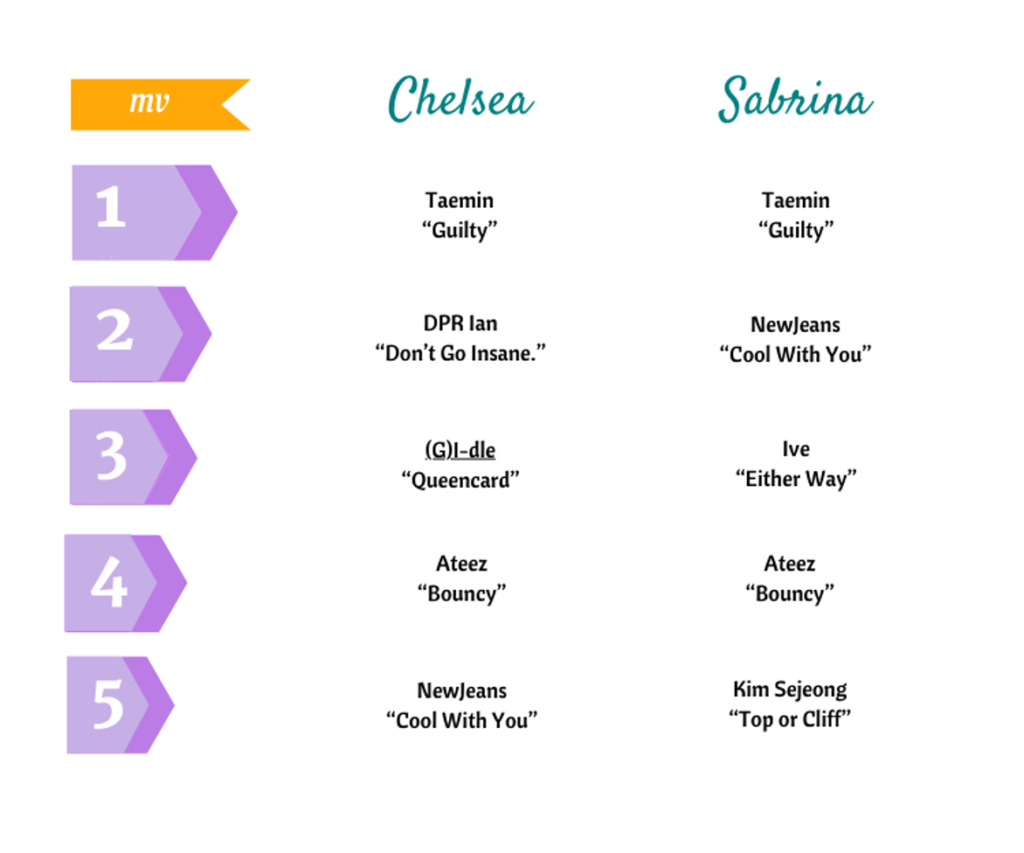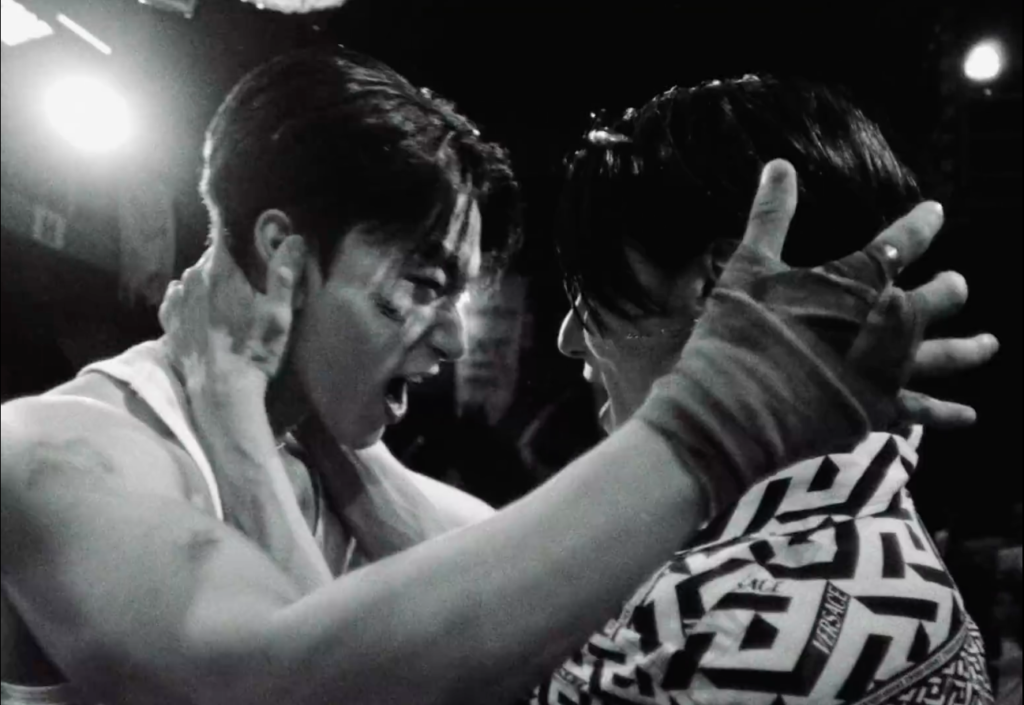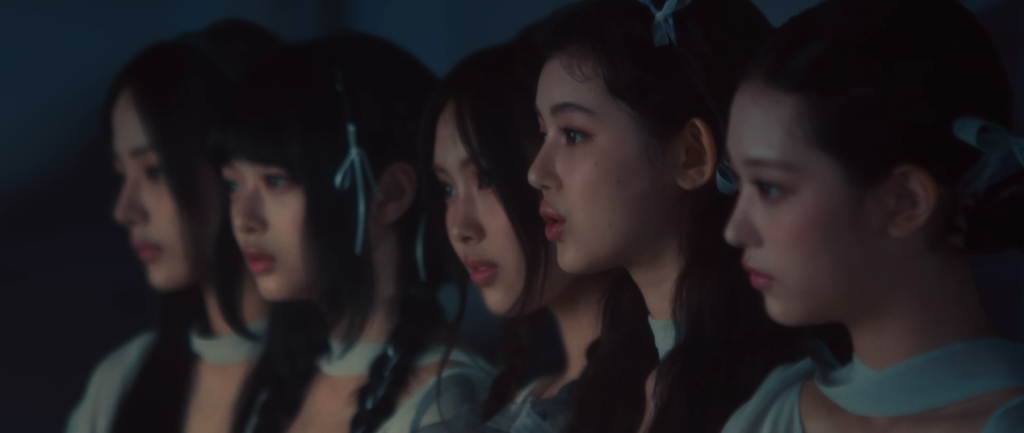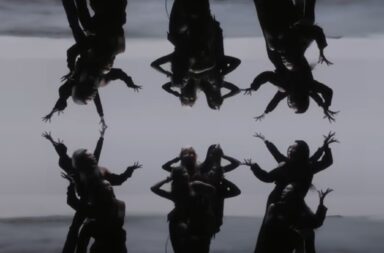As artists increased their output with pre-releases and b-side MVs, 2023 K-pop gave fans more MVs to enjoy than ever before — and the sheer volume of releases was at times intimidating. However, that doesn’t mean 2023 was without it’s stand-outs. Writers Chelsea and Sabrina parsed through their favorites from the sea of 2023 MVs, and discussed what made an MV a cut above the rest.

Chelsea: Another year is coming to an end, and once again the process of narrowing down my favorite releases was more stressful than I was prepared for. With not only so many releases this year, but also so many different styles of MVs, there were too many memorable and well done MVs to list. So, in the end, I settled on the MVs that kept me coming back whether it be for wild chaos or to pick up another layer of symbolism.
I’m happy to see we have a few overlaps — and you’ve chosen several of my runner-ups. I’m wondering what your criteria was for your top five?
Sabrina: As you said, Chelsea, there were so many strong MV releases this year. When determining my list, I looked for creativity, memorable imagery, and impressive elements of film-making. Most important, though, was how visuals and music combine to tell a compelling story or create an emotional impact.
Ive’s “Either Way” is one example of an MV’s visual choices underscoring emotional impact. The MV opens with shots of a galaxy, but also an extreme close-up of a similarly multicolored patch of glitter, appearing to perhaps conceal a bruise. Immediately, this close-up evokes bittersweet feelings that the song and MV continue to develop.
The song’s lyrics are some of Ive’s most vulnerable — addressing perceptions from others that can feel unfair. The MV dramatizes the effect on the Ive members: they wake up in the wardrobe room in a theater, looking in the mirror and, in one member’s case, not seeing her own reflection. The moments with Yujin and notably Wonyoung in overexposed lighting mimic the harsh spotlight that they endure as idols.
The MV is particularly effective in juxtaposing scenes with different moods and aesthetics, moving from blue tints to jewel tones to black-and-white. One of the ending moments of the MV, cutting between a close-up of Yujin wiping away tears and a scene of her dancing among falling confetti, is especially moving. The MV conveys a full spectrum of emotions, grappling with the complexities of resolving one’s identity with other people’s perceptions.
Chelsea, what was it about your picks that kept you coming back to them?
Chelsea: While my list is bookended by more serious and symbolic MVs, the middle picks were all selected because they’re fun, which made re-watching them easy even if the songs themselves weren’t my favorite.
A prime example of this is (G)I-dle’s “Queencard.” The track — though filled with lyrical gems that are as intentional as they are memorable — is not my usual cup of tea (blame the chanted chorus). The MV, however, was able to not only draw on the fun aspect of the lyrics but also pull from every iconic teen movie of my youth to create a blend of nostalgia and silliness. There’s the dance-off from White Chicks, references to Mean Girls… the list goes on. Each time I watch the MV, I feel like I pick up another reference.
I love when a group doesn’t take themselves too seriously. “Queencard” managed to be an appropriate follow-up to the more serious “Allergy,” while also addressing issues of self-image and confidence. It’s a win across the board.
Another MV that made both our lists and also falls under the category of a group not taking themselves too seriously is Ateez’s “Bouncy.” What made it stand out for you?
Sabrina: “Bouncy” definitely does not take itself too seriously! It has a parrot singing the chorus, after all. I loved that it had the swagger and cheekiness needed for a song ridiculously subtitled “K-Hot Chilli Peppers.” It is bold enough to throw together a goat, a singing parrot, saloon shoot-outs, MMA matches, high-speed motorcycle rides, fiery explosions, and a rebellion set off with a bullet hidden inside a pepper. The imagery of the MV is overstimulating in a fun way that perfectly matches the song. Similarly, the frenetic cuts and camera tilts, particularly during the choreo scenes, reflect the song’s off-kilter and unyielding energy.
Like “Queencard,” “Bouncy” playfully refers to movies, as well as Ateez’s own lore in which they battle a repressive dystopian regime. Most of their MVs further their storyline more overtly, but “Bouncy” does this by portraying the group as totally unrestrained. The MV distinguishes itself from the more earnest videos that preceded it (“Guerrilla” and “Halazia”) while still maintaining Ateez’s trademark bombast and exhilarating intensity.
What about “Bouncy” placed it on your list?

Chelsea: Much like you said, “Bouncy” is a case of throwing in everything but the kitchen sink and it working.
Oftentimes, when MVs go for the more is better approach, the final product comes out confusing, disjointed, and difficult to take in. “Bouncy,” on the other hand, excels in its excess. There are not only the movie references and ties into lore, but there’s a lightness and self-awareness to the MV that I really appreciate. In particular, I love Wooyoung and San’s boxing scene where Wooyoung completely embraces his character as a sleazy underground boxing manager. They know it’s silly, we know it’s silly, but everything from the dance to the aesthetics pulls you in and has you watching for a second or third time.
On the note of all the film genres and references, I think special attention has to be put into the camera work and post-production decisions made in “Bouncy.” Each set has stylized camera work that embraces the genre it is presenting, and the cuts between the scenes are done in a way that matches the movement of the song and choreo without feeling too jarring. It’s a masterclass in editing chaos, and I hope other companies can learn from it.
Moving away from our sillier choices, but still in the same vein of stylish excess, DPR Ian’s “Don’t Go Insane” made my list for its mix of aesthetics and message. Within his series of releases, DPR Ian has not only crafted his own dark lore, but a way of expressing his inner world that is both vulnerable and entertaining.
Like other MVs of his, “Don’t Go Insane” is one that pairs light aesthetics with darkness and excess. The campier elements of horror, the neon purple and green color accents, and the exaggerated styling bring fun to the table. However, these are all just a stylized way to express the battle between “insane” and “I’m sane” in the lyrics. DPR Ian is haunted by his demons, persecuted by them, blames himself, and trapped. In the end, he does escape the cross he’s been tied to but only to a dry desert, and still with one questionably sober demon in toe.
“Don’t Go Insane” is one of my favorite songs of the year, and I really respect the continuity of DPR Ian’s MV aesthetics and narratives even through a variety of cinematic styles. While this MV leans more towards wild west camp, the butterflies and masked characters of previous MVs are there. Throughout his series of work, the way he expresses his own mental health ups and downs in a way that is narrative, creative, and intriguing continues to impress me.
Now that we’re on the more cinematic end of our picks, Kim Sejeong’s “Top or Cliff” made your list and also is an impressive narrative and aesthetic feat. What about it made it a top pick?
Sabrina: “Top or Cliff” is a cinematic MV that resembles an action movie, including impressive blocking of fight scenes through hallways and staircases. Kim Sejeong displays the acting ability to pull off a distressed action heroine battling against an entire mansion of people, both in her physicality and in her expressions.
The MV rewards multiple viewings; the first few minutes include some subtle details (like Sejeong stepping over tripwire) that I did not notice right away, though I felt the tension they created. The narrative also holds up to multiple interpretations. With the staff seemingly conspiring against her and literally stabbing her in the back, it is easy to read the MV as a metaphor for toxic fans or demands of society. In a few frames, though, Sejeong is fighting with herself. Whether battling external or internal demons, her conflicts fit with the notion of how easily being on top could turn into a sharp descent off a cliff. In either case, the ending feels like a reclamation of personal power, though at a heavy cost.
Another cinematic video, “Cool with You” by NewJeans, might be my favorite MV of the year in terms of storytelling. Even if one doesn’t pick up on the Cupid and Psyche imagery, it becomes clear that Hoyeon’s character plays a Cupid role from the first few minutes of the Side A version. With every shot, a new piece of information unfolds. The storytelling takes its time, but is consistently engaging. It is also very creative for the NewJeans members to take an ancillary role, observing the action and commenting on it like a Greek chorus.

The slow pacing and attention to detail during the first part of Side A pay off when Hoyeon grows enamored with a man played by Micol Vela and sacrifices her supernatural powers. Scenes build on one another beautifully, such as Hoyeon looking at a couple in an elevator to match them, but later refusing to do so with Vela and another woman. The series of callbacks takes a heart-wrenching turn when Tony Leung appears as another figure with Cupid-like powers, and glances at Vela to make him fall in love with another woman. I wouldn’t have expected to be so invested in a music video story, but Hoyeon and Leung’s acting is compelling (Leung, known for his expressive eyes, is particularly memorable with just a few seconds of screen time).
Chelsea, you also had “Cool With You” on your list. What did you like about it?
Chelsea: To be honest, “Cool With You” was one of the releases I struggled most with this year. For narrative reasons, I was immediately drawn to it. It pulled on the mythology you mentioned, while also hitting City of Angels notes from my childhood. The narrative was compelling, the cinematography was fantastic, and yet it left me feeling a bit uneasy. I want to say this is because of the age of the NewJeans members that are featured in a more mature storyline, but really it was because this MV forced me to confront a big reality about K-pop: sometimes the art is completely separate from the artist.
Yes, NewJeans provide the vocals and their role as the muses is important to the visual story, but the MV still felt very separate from NewJeans as a group. In that way, I was engaged with the narrative of the MV while also being slapped in the face with the reality that it was just a concept and NewJeans half the vessel for it. All K-pop MVs work this way – the members are rarely the ones dictating the styling, the narrative, or even the theme of the comeback. Members perform the track as is styled for them. But “Cool With You,” because of its stark emotional maturity, made this reality all the more apparent. Another group, an older group, could have played a more direct role in the narrative, but that wasn’t ADOR’s vision. They had a narrative and acting titans like Tony Leung to pad the story outside of the NewJeans aesthetic.
Does it detract from it as an MV? I’m still not entirely sure. What I do know is that the versions of the MV are objectively beautiful. They move me and make me contemplate longing, fate, and punishment. A good MV should push us to think about complex topics. At the end of the day, do I think NewJeans were the best vessel for this narrative? It makes my top list because it’s well executed, but I am still not sure NewJeans was the right group to present it.
On the other hand, there is both of our top choice, Taemin’s “Guilty.” This is an MV that is both artistic and deeply personal – as you covered in your brilliant MV review. I know that for me, all the Shinee members deserved to be on my list in one way or another for both their group and solo work this year, but it was Taemin I chose because “Guilty” had the attention to detail that makes each re-watch a new experience.
What about “Guilty” made it your top choice?
Sabrina: First of all, I agree that Shinee had an excellent year. I was not sure that I had more to discuss about “Guilty” beyond my review, so I was tempted to use this space to praise the wit and whimsy of Key’s “Good and Great” or the contemplative beauty of Onew’s “O {Circle).” In the end, though, I had to give “Guilty” my top spot for having every element I look for in an MV: thoughtful choices in every aspect of production, an intriguing narrative, and a strong emotional impact.
Beyond these criteria, Taemin’s music videos are a primary form of his artistry. The director of “Guilty” gave Taemin George Bataille’s Eroticism: Death and Sensuality and the video is certainly interested in pushing boundaries in topics like sex and death, pleasure and trauma. The “Guilty” video not only depicts the feeling of guilt, but invokes it in us. So many elements of the video, from Taemin’s muscular body in youthful costuming, to the ‘killing point’ choreography, feel both alluring and disturbing. I can’t think of another music video that is not only artistic and conceptual, but also confronts and challenges its audience the way “Guilty” does.
Chelsea: Between the masterful solos, the group comeback (thinking “The Feeling” and not “Don’t Call Me”), and their meme-able end of year hosting and performances, 2023 really feels like the year of Shinee. It is only appropriate that Taemin’s “Guilty” would top my list because it is in many ways a culmination of all the dimensions of his artistry. The MV teaser hooked me to the depth of the concept, and although the final MV felt different from the initial teaser, it was no less moving.
Because your MV review did such a good job of breaking down the MV, I won’t delve into all the symbolism, but I will say that I love the darkness of “Guilty.” As you said, the lines between pleasure/pain, guilt/innocence, etc are all tested for both Taemin and the audience. It’s almost an uncomfortable watch, but still mesmerizing. Shout out to how well the choreography — with small but sharp movements — dictated the filming of the MV. Every movement of Taemin’s body guided the camera and scene transitions from the close-ups to the group shots. It created a feeling of tightness, intimacy, and discomfort while also highlighting his skills as a dancer. The camera was us — zooming in, focusing, being disoriented — but altogether it created a continuity of narrative and physicality that I’m in awe of.
Every choice from styling to camera angle was deliberate and effective, and I love to see that SM, to some extent, is still putting in effort for Shinee both as a group and soloists. Each solo has catered to the artistry of the individual member, and “Guilty” just happened to be my favorite this year. As such, I’m excited to see what 2024 brings for Taemin and Shinee. Taemin is an artist at the top of his game, and “Guilty” proves he still has so much to give us.
And that’s all for 2023! We’re looking forward to another year of stellar MVs in 2024.
(YouTube: [1] [2] [3] [4] [5] [6] [7]. Images via: KQ Entertainment, SM Entertainment, ADOR.)


